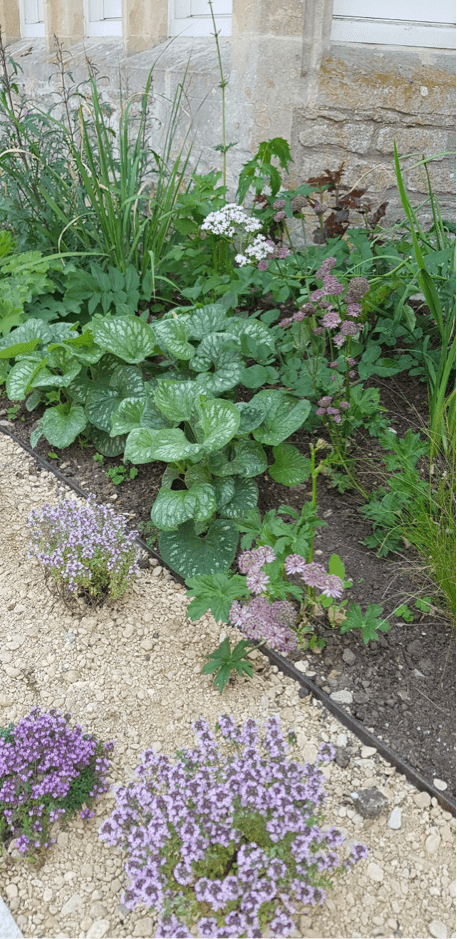Planting: not so straight forward in 2020
February, a grey and wet day the hard landscape is nearly completely finished but the whole place is looking harsh and open. This is part of a large garden renovation project and this is the dining terrace with slate paving and cast concrete water feature and planting trough. By March, half the plant order around 500 little plants arrived on site, days before the whole place had to be shut down, an unexpected event, unprecedented even.
Following a five-week shut down due to Covid19 and May rolls around and the project starts back on site. Our client has diligently watered all the little plants and they are now desperate to escape their pots. This is not the traditional time of year for planting, it is usually done during the colder winter months or early Spring, but all the plants had arrived from the suppliers and there was no choice but to get going. The beds had been carefully weeded and spent mushroom compost dug in to help provide nutrients. Setting out time arrives and it is the hottest May on record.
Traditionally, people put in plants grown in 2ltr pots, as these are well established and showy. The plants. Here we specified them as 9cm pot sizes, they will bulk up by the end of the summer and this saves a huge amount of money, so a good way to stretch the budget. Firstly, we laid the plants out on the lawn in a shady spot, watered them in and organised them into geographic areas of the garden, top terrace and lower garden. Each bed within the different areas has a detailed plan and schedule.
The tricky thing is that along the way, some plants were not available, so substitutions were made back in March and we had to carefully work out – and trawl my poor memory – to work out exactly what and where the alternative plants were to go. Fortunately, I had a very experience gardener and horticulturalist working with me for this job, which makes so much difference, we could also rave about our favourite species, something I rarely get a chance to do, working alongside architects as I do.
Sorting out planting orders and setting out really is a job for people who speak plant language; every name is written in Latin and you really do need to be familiar with what the plant looks like too! In my 20s I spent a year working in a plant nursery in order to become fluent in plant nomenclature, learning what a plant looks like from its roots, shoots, leaves and flowers and what the plant name means. I found this to be one of the most valuable experiences in my life and it also confirmed my passion for plants.
The plants are allocated to their correct beds and we had to make sure everything was watered so much as the temperatures rose.
The temperature continued to rise and we continued to plant. Our client took on the seemingly endless task of watering. The soil is completely parched and the compost blows around like dust.
A couple of weeks after planting and the whole place looks a lot happier, the planting softens the hard landscape. Blocks of yew, hornbeam and purple berberis hedging start to define the area and trees and shrubs create features that will eventually hold the space.
The plants start to fill out, spilling tentatively over the edge of the slate, providing contrasting texture and a splash of colour, here is Geranium ‘Roxanne’ with Stipa tenuissima or pony tail grass.
A beautiful oak bridge rises above the planting bed, this will become a secret route to the lawn once the grasses establish either side.
Above: Where ever I can, I have chosen plants which are attractive to insects, simple forms that were not blowsy, where the stames are exposed like this Valarian (let) and Foxglove ‘Suttons Apricot’.
Above: Along either side of the main path, I have created a strip of gravel mulched plants, such as Thyme, Erigeron karvinskianus with its sweet little daisy flowers and Soleirolia soleirolii, a tongue twister if ever there was one, otherwise known as Baby’s Tears or Mind Your Own Business due to its creeping and sometimes invasive habit – I have to say that on this occasion, the hot weather has meant it is struggling to take hold, but I am sure it will survive.
I wanted to introduce a them of planting either side of this long path and included varieties of Astrantias, mainly pinks, Brunnera Jack Frost and Hadspen Cream for their variegated foliage as well as grasses and Rosa Darcey Bustle for a pop of deepest pink rosiness.
The lower garden beds surrounding a petanque pitch after a few weeks of growing have suffered no losses and considering the heat, this is a credit to the waterer.
Above: I was so excited to see these beauties, Echinacia pallida with its delicate pale pink falling petals and Iris Kent Pride with its slightly brick coloured flowers, looking so well with the rusty Corten steel walls.
As can happen sometimes, there were gaps where plants could not be sourced by the wholesalers at the time of ordering and it is then my absolute pleasure to take a trip to a wholesale nursery myself to pick out some specimens. Trade nurseries like this one are not usually open to the public, but more and more are open once a week or have annual plant sales to clear old stock; so if you know your stuff, you can also make a visit, always call ahead. There is no one to ask how something will grow and certainly no café, but it is well worth the effort of running around in order to fill your garden for hundreds instead of thousands of pounds. http://www.wknurseries.co.uk/


















